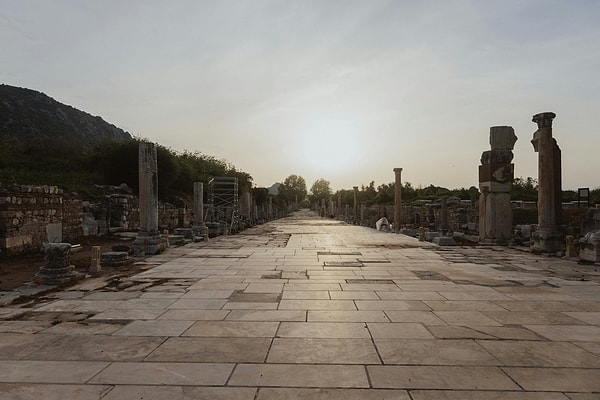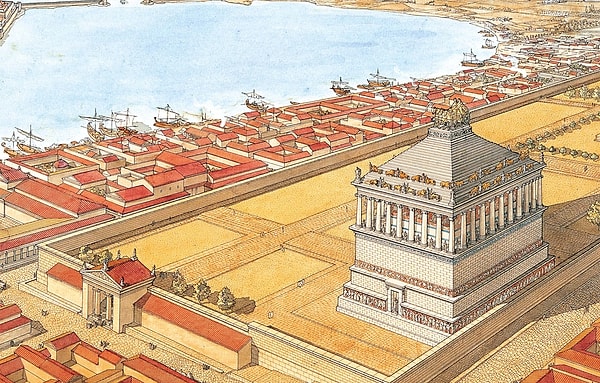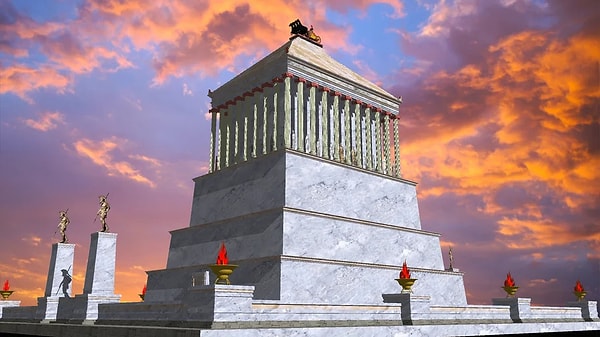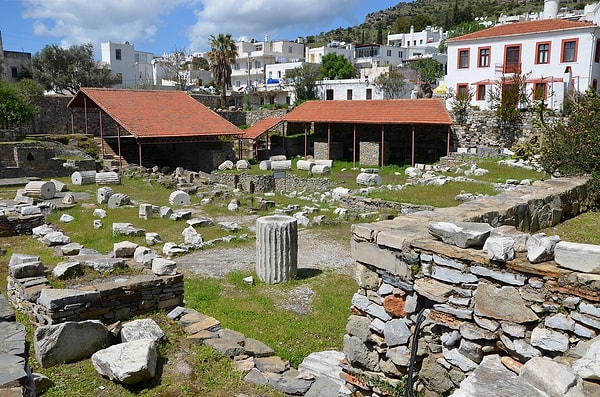Explore Turkey’s Ancient Marvels: Home to 2 of the 7 World Wonders
The Seven Wonders of the World remind us of the architectural genius of the ancient world and the turning points in human history. These wonders have been studied for thousands of years by historians, archaeologists, travellers and culture enthusiasts as the most magnificent structures ever built by human hands. Two of these seven structures are located in Anatolia, within the borders of modern-day Turkey: the Temple of Artemis in Ephesus and the Mausoleum at Halicarnassus. In this article, we will examine the historical significance, architectural features, cultural backgrounds, and current conditions of these two unique structures in detail. So, what are the wonders of the ancient world in Turkey? Let's explore together!
How Many Wonders of the World Are There in Turkey? Why Are Only These Two Structures Left?

There are only two structures within Turkey's borders on the list of the Seven Wonders of the Ancient World: the Temple of Artemis in Ephesus and the Mausoleum at Halicarnassus. This clearly shows how important Anatolia has been as a centre of civilisation throughout history. However, only the ruins of these two structures remain today. The main reason for this is natural disasters, particularly earthquakes and fires, as well as destruction caused by human activity. Additionally, many of the stones from these structures were removed for use in other buildings; for example, the marble from the Mausoleum of Halicarnassus was used in the construction of Bodrum Castle.
Although there are other important ancient structures in Turkey besides these two, only the Temple of Artemis and the Mausoleum of Mausolos managed to make it onto the list of the ‘Seven Wonders’ compiled by ancient writers. The remaining five wonders are located within the borders of different countries today, such as Egypt, Iraq, Iran, Greece, and Italy. This once again highlights Turkey's architectural and cultural significance in world history.
The Temple of Artemis at Ephesus: The Ancient World's Miracle Dedicated to the Goddess

Located in the Selçuk district of Izmir, in the area known today as the Ancient City of Ephesus, the Temple of Artemis is considered one of the Seven Wonders of the Ancient World. This temple has played a central role for centuries, not only because of its magnificent architecture, but also because of its religious and cultural function.
History and Construction of the Temple
The construction of the Temple of Artemis began in the 6th century BC with the financial support of King Croesus of Lydia. The construction was carried out by the famous architects of the time, Chersiphron and his son Metagenes, and took approximately 120 years to complete. According to ancient sources, the temple was surrounded by more than 120 marble columns. Each of these columns, approximately 18 metres in length, encircled the temple on all sides, giving the structure an almost divine appearance.
However, the temple's original form did not last long. In 356 BC, a man named Herostratus set fire to this magnificent structure in order to make his name in history. Ironically, he achieved his goal and his name was not forgotten. After the fire, thanks to the determination of the people and their desire to rebuild, the Temple of Artemis was rebuilt in an even larger and more magnificent form.
Religious and Cultural Significance
The temple is dedicated to Artemis, one of the most important goddesses in Greek mythology. Artemis is associated with nature, hunting, childbirth and femininity, and was worshipped in Ephesus particularly as a goddess of fertility. Unlike classical Greek iconography, Artemis of Ephesus is depicted as a multi-breasted figure, symbolising fertility and life. In this respect, the temple is not only an architectural marvel but also a central element of pagan belief systems.
The temple's religious function was not limited to worship; it was also used as a sacred area offering asylum. Murder suspects, slaves, and political criminals sought refuge here to gain immunity. This practice continued even during the Roman period, making the Temple of Artemis a part of social life and political balance.
The Temple of Artemis Today
Today, only a column and the foundation stones remain at the site of the temple. This may seem insufficient to visitors, but the archaeological significance of the area and the mere imagination of the temple here is fascinating. Some of the pieces excavated in Ephesus and its surroundings are on display at the Ephesus Museum in Selçuk. Additionally, some of the temple's statues and decorations can be seen at the British Museum.
The Mausoleum of Halicarnassus: A Gift of Eternity to a Ruler

Located in the Bodrum district of modern-day Muğla province, the ancient city of Halicarnassus was home to one of the rarest monuments in history: the Mausoleum at Halicarnassus. This structure has taken its place in world cultural heritage not only as an architectural marvel of the ancient world, but also as the origin of the word ‘mausoleum.’
Construction Process and Architectural Features
The mausoleum was built by Artemisia II, wife and sister of Mausolos, the Satrap of Caria, who died in 353 BC. The structure is approximately 45 metres high and is decorated with reliefs carved by different sculptors on all four sides. These artists were Scopas, Leochares, Bryaxis and Timotheus, leading names in Greek sculpture.
The architectural structure of the mausoleum was a synthesis of Greek, Egyptian and Lycian styles. The rectangular structure, made of marble, was crowned with rising columns and a sculpture of a chariot drawn by four horses at the top. In this respect, the Mausoleum of Halicarnassus was one of the rare examples reflecting both the technical capacity and aesthetic understanding of the period.
Cultural and Universal Impact
One of the most significant impacts of the Mausoleum of Mausolus is that the word has become generalised over time and is now used to describe any type of monumental tomb. Today, the word ‘mausoleum’ is derived from this structure and is pronounced similarly in every language. The structure is a symbolic monument that combines the belief in life after death, a display of political power, and artistic grandeur.
This magnificent structure, which stood for approximately 1,500 years, suffered extensive damage from earthquakes during the Middle Ages. In the 15th century, the Knights of St. John in the region used the stones of the mausoleum to build Bodrum Castle. As a result, many parts of the mausoleum are now found within the castle. Only the foundations, some architectural elements, and a few statues remain.
Current Remains and Museum Connection
Today, the remains of the mausoleum can be seen in the open-air archaeological area in the centre of Bodrum. Although the area is limited, the plan and foundations of the structure are clearly visible. Additionally, some original sculptures and reliefs from the mausoleum are preserved in a special gallery at the British Museum.
Source: NAT GEO
Why Are Turkey's Ancient Wonders Important?

Turkey is not only a geographical crossroads of civilisations, but also a cultural and historical one. Therefore, the presence of these two unique structures from the ancient world on Turkish soil reinforces the country's importance in terms of archaeological and cultural heritage.
The Temple of Artemis and the Mausoleum of Halicarnassus are not only symbols of the splendour of the past, but also valuable in terms of Turkey's role in tourism, culture and academia today. Thanks to these structures, Turkey continues to be a unique destination for ancient history enthusiasts, architecture students, archaeologists and travellers.
Source: 3D Warehouse
How to Get to the Ruins of Ephesus and Halicarnassus

The ruins of the ancient city of Ephesus and the Temple of Artemis are located within the boundaries of the Selçuk district of İzmir. After landing at İzmir Adnan Menderes Airport, it is possible to reach Selçuk in about an hour by road. You can reach the ruins of the ancient city of Ephesus and the Temple of Artemis in a short time by minibus or on foot from the centre of Selçuk. Some of the artefacts excavated from the temple are on display at the Selçuk Ephesus Museum.
To reach the ruins of the Mausoleum of Halicarnassus, you need to go to the Bodrum district of Muğla. It takes about 35 minutes to reach the city centre from Bodrum Milas Airport. The mausoleum is located in the centre of Bodrum, within easy walking distance. The open-air museum where the ruins are located is open to visitors throughout the year. In addition, important parts of the mausoleum are on display in a special hall at the British Museum (London).
For those who want to see these two wonders in person, both transportation and the visiting experience are quite convenient. Ephesus and Bodrum are definitely two destinations that history and culture enthusiasts visiting Turkey should not miss.
Source: By FollowingHadrian
Turkey at the Heart of History

These two ancient wonders of Turkey are revolutionary works of architecture and culture that have left their mark on human history. The Temple of Artemis in Ephesus and the Mausoleum at Halicarnassus not only bear the traces of the past, but also remind us today of how deep and impressive civilisation can be. Each is a unique example of how humanity's relationship with nature, the gods, and death is reflected in architecture.
Visiting these two magnificent ancient sites is not just a trip but a journey through time. Turkey is one of the best places to embark on this journey.
Keşfet ile ziyaret ettiğin tüm kategorileri tek akışta gör!

Send Comment